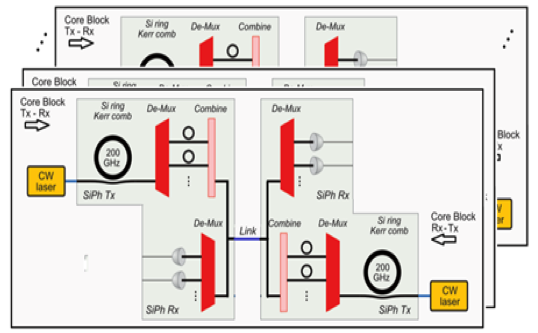Penn-led Team Receives DARPA Grant to Develop Electronic-photonic Chips for Highly Efficient Data Transfer

By Lauren Salig
A team led by Penn Engineering’s Firooz Aflatouni has received a grant from the Defense Advanced Research Projects Agency (DARPA) to develop a low-power integrated platform that can transfer and interpret over 100 terabytes of data per second — an amount of data tens of thousands of times larger than what a typical modem can handle.
DARPA is an agency of the U.S. Department of Defense that invests in breakthrough technologies to support national security. The award is part of DARPA’s Photonics in the Package for Extreme Scalability (PIPES) program, which aims to revolutionize digital microelectronics by utilizing new, high-bandwidth optical signaling technologies.

Firooz Aflatouni, Skirkanich Assistant Professor in Electrical and Systems Engineering, will lead the project, collaborating with scientists from Stanford University, the National Institute of Standards and Technology and the University of Central Florida.
The grant provides the multi-disciplinary team with $4.6 million for three-and-a-half years to further the goals of the PIPES program, namely their goals of improving data transfer and scalability. The question raised by DARPA in the PIPES program is how to transfer a massive amount of data on optical fibers while using very little power and space.
“Why is this important? Even today, optical signals are used to carry large amounts of information in some places, such as Google or Amazon data centers,” says Aflatouni. “The goal here is to make data transfer much faster than what we have in today’s data centers but with far less power and using a much smaller area for the same task.”
To build a technology that meets the PIPES program’s rigorous efficiency goals, Aflatouni’s team has proposed a novel way to transfer and process more than 100 terabytes of data per second using chips that each occupy only a few millimeters of space. Each chip uses numerous parallel channels, all with slightly different features, to transmit and receive data. Within each channel, a large amount of data in the electrical domain is encoded into a beam of light called an optical signal.
These data-carrying optical signals differ in frequency, or as Aflatouni describes it: “how many times per second they toggle.” This distinction in frequency allows an electronic-photonic chip to distinguish the signals and reconstruct the original information being relayed once the signals reach their destination.
To transfer 100 terabytes of data per second through these optical channels, Aflatouni’s team proposes a method that allows encoded optical signals to travel concurrently through the same optical fiber without interacting with one another.
“We use a laser to generate all required optical signals with slightly different frequencies, which we call an optical comb. The comb teeth, as a set of many optical signals, are then used to carry massive amounts of data each. At the destination, data is extracted from each comb tooth,” Aflatouni says.
By separating data into comb-like signals, the team is able to break a massive amount of data into smaller pieces that are recompiled once the optical signals reach their desired destination. This particular comb generator is especially efficient thanks to its unique combination of electrical and optical components.
“The novelty of our approach is to design and place the comb generation system and all other required electronic and photonic devices on the same chip as opposed to having different parts on different chips, which generally makes the connection and communication between different chips very challenging,” says Aflatouni.
Although DARPA’s mission is to develop new technologies that support national security, the system Aflatouni’s team is developing for the PIPES program could have a much broader impact.
“Besides data centers, such technology would be useful for other data-intensive applications such as high-performance computing, machine learning, artificial intelligence and advanced sensors,” says Aflatouni.
